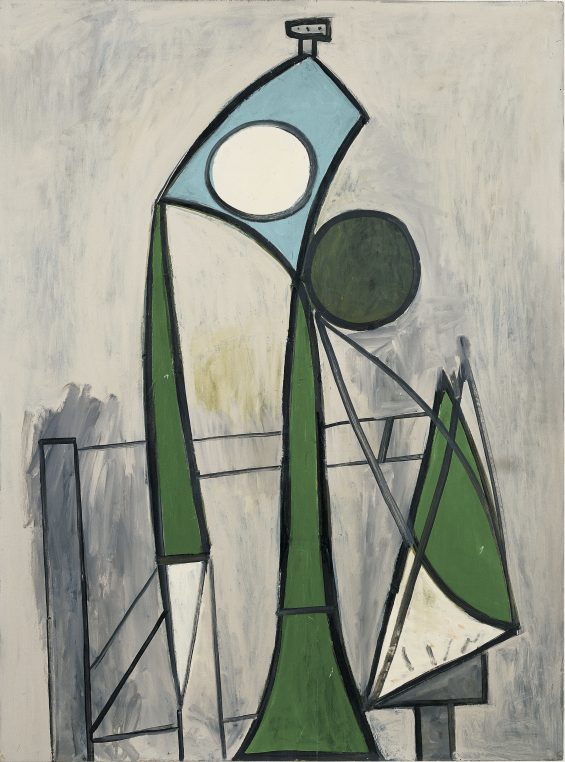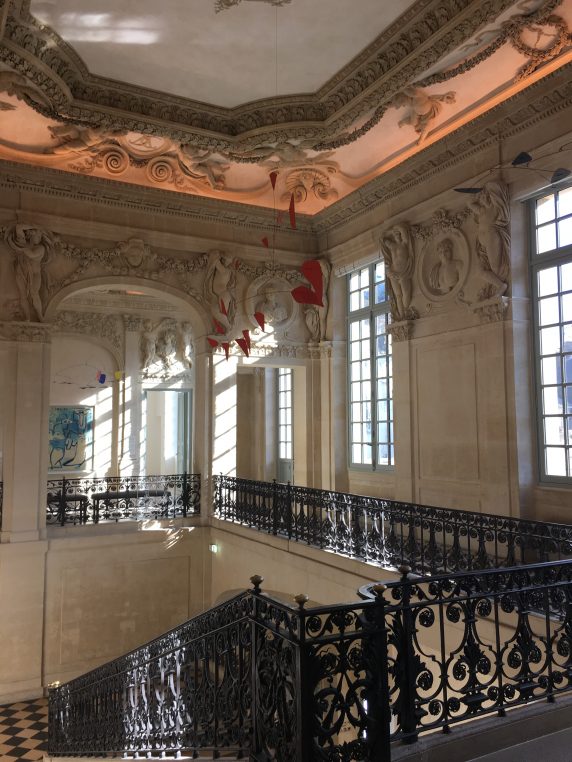
Pablo Picasso, Figure (Project for a monument to Guillaume Apollinaire), Paris, Fall 1928, Iron wire and metal sheet, Musée national Picasso-Paris,Dation of the Estate of the Artist, 1979 © Succession Picasso 2019
There are moments in life when you feel blessed by God and visiting the dazzling Calder-Picasso exhibition at Musée Picasso yesterday, in the full midday sun, was one of these. The 120 sculptures and paintings by the two masters, who met only four times in the course of their lives, are whimsical and aerial, strong and dark at times, and the lay out of the superb 17 th century Hotel Salé gives it a very special chic. Do not miss the show!

Alexander Calder, Wooden Bottle with Hairs, 1943, Wood, steel wire, and nails, Whitney Museum of American Art, New York © 2019 Calder Foundation, New York / ADAGP
Like the first lines of a good novel, the first room gives you instantly a sense of the success of the association of two fulgurant talents of the 20 th century. The show focuses on the exploration of void or of “no-space” which they have both represented up to abstraction. In his “Project for a monument to Apollinaire”, Pablo Picasso uses transparence in sculpture. In the same room a mobile in wood, metal and string by Alexander Calder introduces the notion of movement: Marcel Duchamp is the first to call this new type of kinetic sculpture a “mobile”, a erm which will adopted for Calder’s sculptures.

The successful scenography is by Jasmin Oezcebi: Center, Alexander Calder, Vertical Foliage, 1941, Red Pannel, 1936 and “Constellation” on the wall. Pablo Picasso, “Portrait of a young girl”, 1936 on the right.
This name will stick to Calder and will become his identity. Calder was seventeen years younger than Picasso and they met for the first time in 1931 at Galerie Percier where the 33 year old sculptor took him around his exhibition. He had already done “Joséphine Baker IV” and “Hercules and the Lion” both in 1928. But little by little his sculptures had become more abstract and “Le lanceur de poids” is his last figurative work in 1929.

Alexander Calder, Le Lanceur de poids (the shot putter), 1929, Centre Pompidou, Gift of the artist 1966
In many of his paintings, Picasso used lines and void. And “Femme dans un fauteuil”, inspired by Françoise Gilot in 1947, is an example. Strangely enough, his “Taureau” of December 1945, a lavis drawing, is reminiscent of Calder’s sculptures.
There are twelve rooms in this show curated by Claire Garnier and Emilia Philippot from Musée Picasso, and both Alexander S.C. Rower (Calder’s grandson) and Bernard Ruiz-Picasso (Picasso’s grandson) contributed to the project and lent many works. They will give a joint conference on June 25 at 6.30 pm.

Pablo Picasso, Femme, Paris, June 8, 1946, Fundación Almine y Bernard Ruiz-Picasso para el Arte (FABA), Madrid, © FABA photo : Eric Baudouin © Succession Picasso 2019
I was surprised when I tried to guess which artist had done which sculpture for some are deceptive. Calder used some rough material like in “Morning Cobweb” and Picasso drew some very fine models. What I mostly loved was meandering in the brightly lit white rooms, where red mobiles come out and the pure aesthetics of the works jumps at your eyes. Every single work is interesting and hangs in response to another.
Alexander Calder died in November 1976 in New York a few weeks after the opening of his major retrospective at the Whitney Museum and three years after Pablo Picasso who died in Mougins in 1973.
Until August 25, Musée Picasso and at Museo Picasso Malaga from September 24 to February 2, 2020.
Share this Post


One Comment on “Calder-Picasso, what a fascinating conversation!”
Looks really outstanding Laure .. Calder is such a great artist… Hope to see you very soon.xxx VIRGINIA